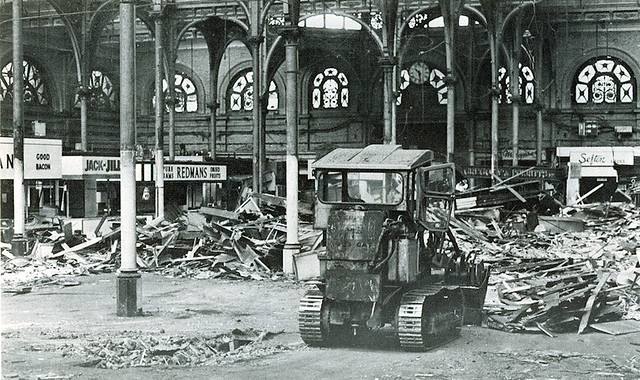Bradford Market Move
Written by Paul Waley

Image: Kirkgate Market Interior (Demolition), Bradford, by Bradford Timeline, licenced under CC BY-NC 2.0 https://flic.kr/p/8TypdG.
Markets4People Co-Investigator and Bradford Civic Society Place Panel, co-chair
After years spent languishing in a nondescript shed, Bradford’s central food market is to move into a purpose-built building in the centre of the city. This will, the Council hopes, catalyse regeneration in the city centre. There is certainly much to appreciate in the new plans, but will they result in a market that manages the trick of both retaining its current customer base and helping bring new energy to the city centre? This is the central issue that is briefly considered below.
Bradford’s impressive Victorian Kirkgate Market, dominating the city centre, was demolished in 1972. Since then, the city’s central market has had a somewhat peripatetic history, ending up split between its undistinguished shed, the Oastler Centre, in the north of the city centre and part of a floor tucked away in the Kirkgate Centre, the building that replaced the market.
This has long been recognised as an unsatisfactory state of affairs. In 2016, promising plans were announced to open up and realign the Oastler Centre market so that it faced east, creating space for outdoor stalls. No sooner had these plans been put together than the supermarket Morrisons announced that it was closing its city centre store adjacent to the Oastler Centre. As a result, the plans were considered to be no longer viable.
A year earlier, a large conventional shopping mall, the Broadway, had opened in Bradford, reorienting the city centre, and a within a couple of years stores such as M&S had closed their existing branches and moved into the Broadway. Relocating the Oastler Centre market into the space left by these retailers in the city centre, between its existing site in the north and the Broadway in the south, seemed the ideal solution to the blight of shop closures in the city centre. In addition, this would place it across the street from the non-food market in the Kirkgate Centre.
The market move is now happening – and at some speed. Plans were approved in April 2019 and compulsory purchase orders have been released. The market will occupy the former site of Bradford’s M&S store on Darley Street, with an open space to be created next door for market-related activities. Completion is planned for autumn 2021 at a cost of £21 million pounds. The new market will only contain food stalls. Non-food stalls will be moved into currently unoccupied space in the Kirkgate Centre market. The new building is designed by Grieg & Stephenson, the specialist firm responsible for Borough Market in London as well as markets in Leicester, Preston and Hong Kong. Their plans envisage a canopy roof and a lower and upper ground floor and a first floor around an atrium.
It is very much to be hoped that the market will have a long and successful future in its new site. However, a number of concerns exist around issues of accessibility, affordability, design and consultation. On accessibility, the new market will be located on a relatively steep slope at some distance from the nearest bus stops. Elderly customers who use public transport might well struggle to carry their shopping back home. While rents for stall-holders are set to rise in a staged fashion, rise they will. This cannot but affect the price of produce and in the longer term the nature of the stalls and therefore the customer base. The design, however imaginative and otherwise successful it might be, is likely to accelerate this kind of change. Market managers and the team responsible for the market’s move have given assurances that these factors have all been taken into consideration.
Some in Bradford were surprised by the speed in implementing the plan to move the market and the lack of time for consultation. This is, after all, a project that raises substantial questions about the sort of city that Bradford is today and the sort of city it wishes to become. Bradford’s post-war history is littered with planning mistakes that have proved hard if not impossible to rectify later.
Having said that, one must hope that the new market will be able to square the circle of retaining its existing stalls and customer base while catering to a new, younger and perhaps more affluent clientele, a sort of gentrification without displacement. In the meantime, in the two years or so before it moves downhill, it is important to ensure that the existing market is not allowed to shrink to a point where there is not much left to move.
